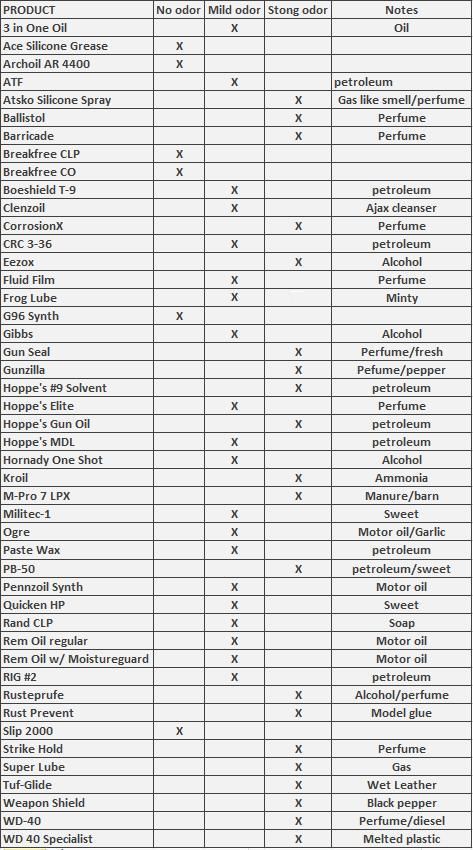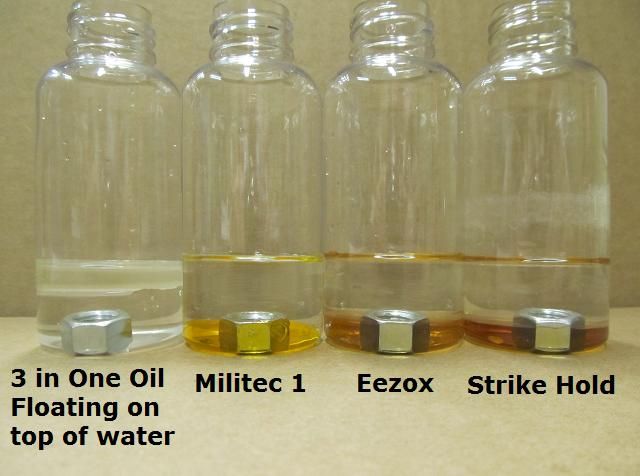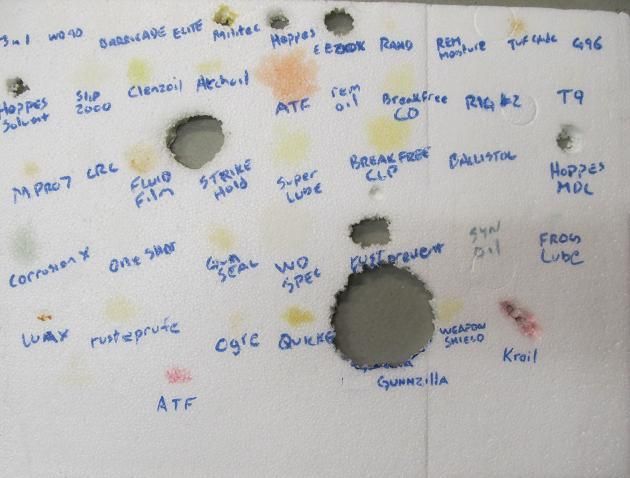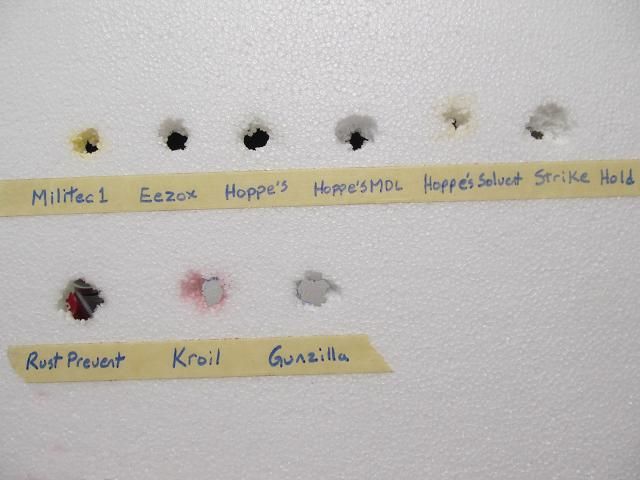You probably recognize many of the products in the lineup. Most are dedicated products marketed to the sportsman for this purpose but some are products that over the years have been used by sportsmen that are not necessarily marketed for this purpose. One such example is simple paste wax and Kroil which were recommended to me by people living in coastal environments. Another is WD 40 and 3 in one oil which have been used by everyone that owns metal since the 1940's. These are not marketed as a gun care products but since they are used by so many in that regard, they were thrown into this evaluation for comparison sake. All products were purchased from either local retailers, online or at gun shows with the exception of the Pennzoil motor oil. I secured that from the local speedy oil change location and only a small amount for this evaluation.
First up is an evaluation of Smell/odor:
Because my primary passion is bowhunting followed by gun deer hunting, scent/odor is important to me. If a product stinks to high heaven I am less likely to use it even if it offers other benefits. Gauging odor is pretty subjective since something that smells bad to me might be appealing to the next person. I will evaluate odor as best as I can.
While this evaluation might seem firearms-centric I’m hoping to come away with products that I will also use during bowhunting trips on things like my bow, broadheads, knives, pruning saws, treestands, climbing sticks, camera arms and other items I take afield as well as my firearms and hunting gear that I want to protect from corrosion. For that reason, odor/scent is something I pay close attention to. Some of these products have an odor that is present straight from the container that dissipates quickly after drying while some products continue to smell long after application. A strong odor even if its pleasant is still a strong odor and something I hope to avoid in the products I use.
I created the following ranking for odor.
No odor
Mild odor
Strong odor
And then any notes about the particular odor. I wrote down the first thing that popped into my head after taking a wiff of each product. See the data below.
**NOTE**This exercise may not account for much once you factor in the dissipation factor once dry and the scant amount left after wiping off the excess product but since I had to use each product I noted the smells and recorded them.

Next up in this evaluation is the water displacement claim. In regards to water displacement, the implied message is that the product, if applied to a wet gun/bow/tool will drive out (displace) the moisture and then protect the metal from moisture and corrosion. This is a pretty easy claim to prove or disprove since the very definition of displacement occurs when an object that is introduced to water, pushes the water out of the way and takes its place (displacing the water). If a product simply floats on top of water, it does not “displace” it.
If the product doesn’t break the surface tension of water, penetrate and displace the water to reach metal parts, then for the purposes of this evaluation It won’t be counted as a water displacer. In contrast, those products that break the surface tension of water, displace the water and penetrate it will be counted as water displacers. This will be done with the raw product directly from their container and NOT the dried or cured product after the propellant, carriers or distillates evaporate or dissolves.
The process of evaluating water displacement is as follows.
1. A container is partially filled with water
2. Raw product (from its original container) is introduced to the water filled container.
3. The product is observed and noted as to whether it displaced (penetrated, broke the surface tension) of the water or whether it simply rested on top of the water.
It should be noted that the ability of a product to displace water does not automatically imply that it will inhibit rust or provide lubrication. A rock or brick (if placed in a container of water) will displace water but will offer no corrosion protection or lubrication. Simply because a product can actually displace water does not automatically translate into corrosion inhibiting or lubrication properties.
Rust inhibiting and lubrication will be evaluated separately but so many of the products made a point of claiming water displacing properties that I thought it worth evaluating. In the grand scheme I dont know if water displacing is going to amount to a hill of beans since lubrication and corrosion fighting can take place even if the product does not displace water but so many of the products made the displacement claim that I opted to evaluate it.
Results: The vast majority of the products evaluated DID NOT displace water. 3 in one oil is a good example. It was in no way a water displacing agent but to its credit, it does not claim to be.
Rather than listing each product and whether or not it displaced water, Here are the only 3 that DID displace water as well as a look at 3 in one oil as a comparison. The water displacing products are:

The picture above can be a bit deceiving. The 3 water displacers look as if a thin film of product is floating on the water. That is not the case. What you are seeing is the surface tension of the water acting like a mirror. You can tell by looking closely to see the reflection of the top of metal hex nut that looks to be floating on that thin film. There was no floating compound on the surface of any of the 3 products. I then rolled and tilted and shook the bottle to see if the compound clung to the metal surface and kept water off the metal part. In all cases, the metal part was coated in the compound and resisted water clinging to the metal. After this agitation I allowed the bottles to rest for an hour to see if the compound separated or changed in any way after being exposed to the water. No change was noted. I did however observe some changes to the plastic bottle that held the Strike hold product. Notice the impact Strike Hold had on the plastic bottle. That leads me to the next area of interest.

Compatability:
Next up is evaluating compatibility with non-metal compounds. This is a tough claim to challenge since there are more plastic and rubber compounds and types of finishes than anybody could possibly check. Some products clearly stated they are not safe for rubber or plastic or finishes and cautioned the user to first test on a discrete location. Other products stated they are safe for (or outright encouraged use) on finishes, leather, wood, etc while still others made no warning nor statement in this regard. A simple check for reaction is to place a small amount of each product on polystyrene (Styrofoam) and observe the reaction. We know what Gas and Acetone do to Styrofoam and we wouldn’t use those harsh products on our gun finish or plastics or rubber so I will use that as a base for this evaluation. Compounds known to destroy polystyrene are Gasoline, Benzene, Toluene, Acetone, Xylene. There are other agents harmful to polystyrene but you get the point. Since its not practical to do a compatibility evaluation with every known type of plastic and every type of gun finish and paint, I only tested polystyrene and took the warnings about compatibility from the product labels.
The majority of the products did not harm nor soften polystyrene. Here is the sheet I used for the evaluation.

Here is an easier to read image of the products in this evaluation that dissolved polystyrene. It should be noted that all 3 water displacers were harmful to the evaluation sheet of polystyrene yet 6 other products that were not water displacers were also harmful to the sheet.
